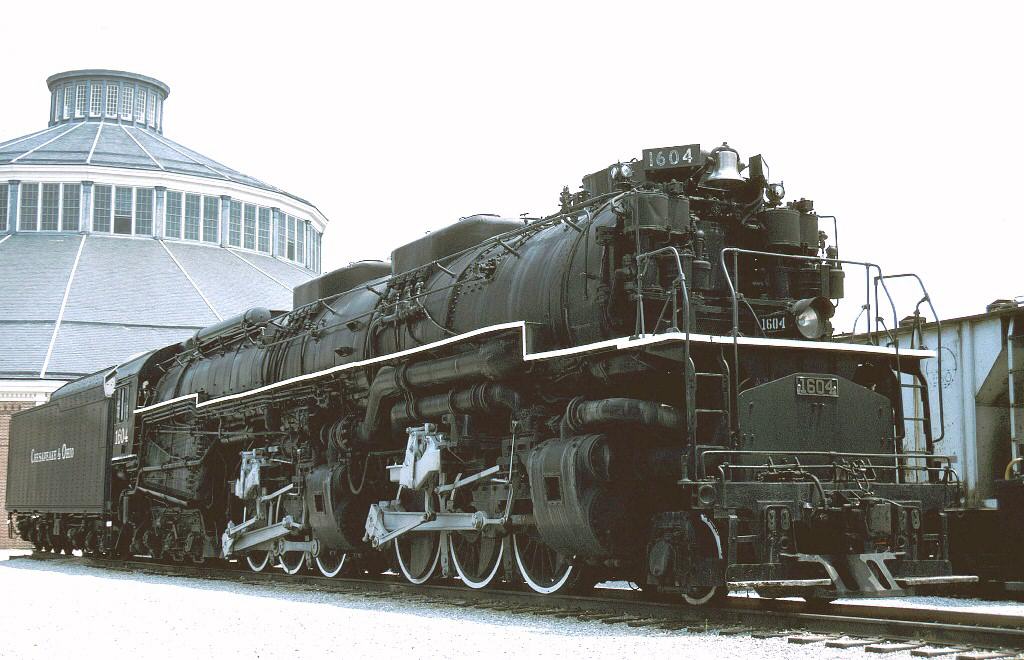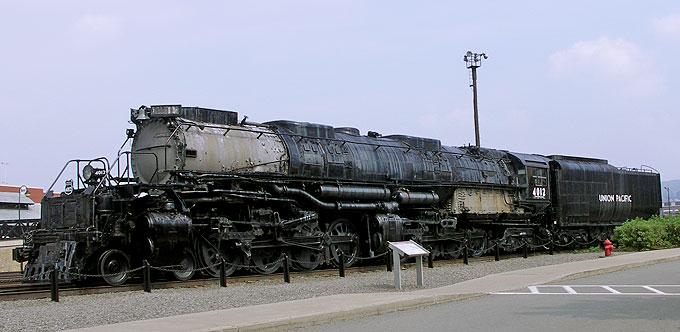Skip to comments.
US Freight Railroads – Another Capitalist Success Story
Redstate ^
| 12-9-11
| Nikitas3
Posted on 12/12/2011 12:26:17 PM PST by bigbob
If you want to see where the American left wants to take us, just look at the history they want us to ignore.
One of the most egregious examples of failed socialist policy is in the area of transportation.
In the post-World War II period you would have expected America’s freight railroads to have been thriving in a booming economy. But the opposite happened.
By 1972 many major freight railroads had gone into bankruptcy including the venerable New York Central and the behemoth Pennsylvania. Other failures included the Boston & Maine, Lehigh Valley and Reading.
CEO Benjamin Biaggini of the Southern Pacific, the “railroad that built California”, a company long considered an invincible goliath, was expecting by that time that the freight railroads would collapse and would be nationalized. Even his mighty empire was suffering.
What caused all this to happen in this period of unparalleled prosperity?
[edited due to posting length restrictions]
Yet today America has more interstate highways than ever while the freight railroads have rebounded and are a fiscal juggernaut making healthy profits with an ultra-modern and very competitive alternative to trucks on the highways (22,000 locomotives, 140,000 miles of track and 1.5 million cars moving 1.9 TRILLION ton-miles of freight annually). And the railroads are expected to make big economic gains over the next 10 years as more new laws regulate trucking and a driver shortage plagues the industry.
Why have the freight railroads rebounded?
Because they were de-regulated, that’s why…
(Excerpt) Read more at redstate.com ...
TOPICS: Business/Economy
KEYWORDS: capitalism; deregulation; railfreight; railroad
Navigation: use the links below to view more comments.
first 1-20, 21-28 next last
Capitalism and conservatism: Work Every Time They're Tried
A good article, worth reading.
1
posted on
12/12/2011 12:26:32 PM PST
by
bigbob
To: bigbob
Mainly because they abandoned tens of thousands of miles of track, in short they downsized. They still have the same physical problem. That is a truck will have the fright in the warehouse on the east coast before the railroad will get it out of the rail yard in California. Where is willie green?
2
posted on
12/12/2011 12:37:37 PM PST
by
org.whodat
(Just another heartless American, hated by "AMNESTY" Newt, Willard, Perry and his fellow supporters)
To: bigbob
In fact, even the government created entity formed from six bankrupt Northeast RRs, Conrail, was able to be sold at a profit for the US Government. Once the regulations were removed in the early 80’s, it opened the floodgates to prosperity.
To: org.whodat
Willie Green was a supporter of passenger railroads.
Freight traffic did not interest him...
He was on weird fellow...
To: JenB
5
posted on
12/12/2011 12:45:32 PM PST
by
TalonDJ
To: bigbob
Did someone mention rail freight and capitalism in the same breath??:
 Chesapeake & Ohio #1604 The locomotive is a 2-6-6-6 Allegheny
Chesapeake & Ohio #1604 The locomotive is a 2-6-6-6 Allegheny
Courtesy of Steamlocomotive.com
Built for C&O for 100 car coal drags out of White Sulfur Springs W. Va. 1941-1948.
110,211 lbs tractive effort. Heaviest US locomotive ever built.
The Allegheny and many other large steam locos were key to the US winning WWII.
6
posted on
12/12/2011 12:51:33 PM PST
by
RSmithOpt
(Liberalism: Highway to Hell)
To: org.whodat
“That is a truck will have the fright in the warehouse on the east coast before the railroad will get it out of the rail yard in California. “
All the while, the truck is subsidized by the taxpayers. Freight railroads are very efficient at moving large quanities of items long distances. Trucks have their place in the long haul — short hauls to the customer from the rail yard or high priority long haul. However, that high priority long haul should be available at the real price and not be subsidized by the taxpayers.
To: org.whodat
“Mainly because they abandoned tens of thousands of miles of track, in short they downsized.”
Yes, they got rid of old outdated lines that made no sense to operate (and pay tax on the property). Also, the Class A RRs sold many of those low profit lines to short lines (with non-union labor) who can operate those lines at a profit. Overall, the system worked because the government got out of the way.
To: Le Chien Rouge
Yes, someone told we a location where poor willie posted, I did not think it was worth remembering. A train is good at bulk hauling, coal, oil, chemicals, autos, and truck van freight if you have a couple of weeks delivery time. Not much else. Back when they hauled cattle by rail the loss of animals was staggering.
9
posted on
12/12/2011 1:03:19 PM PST
by
org.whodat
(Just another heartless American, hated by "AMNESTY" Newt, Willard, Perry and his fellow supporters)
To: RSmithOpt
I'll see your Allegheny and raise you a Big Boy:

10
posted on
12/12/2011 1:09:43 PM PST
by
ZirconEncrustedTweezers
(There are two kinds of people: those who divide people into two kinds and those who don't.)
To: org.whodat
Intermodal transport mechanisms now dominate freight.
When you go back to the mid-1960s and take a look at the Trans Pacific tariff hearings the basic design specs for Sea-Tainers, Trollies for Sea-Tainers, and TOFC (truck on flat car) parameters, you quickly see that they were the controlling factors. In earlier times the negotiators would have been looking for ton-mile charges, demurage rates and international certifications of compliance.
Literally everybody in the transportation industry around the world, in every country, with whatever degree of sophistication, was in on this one.
The result was the selection of several international intermodal containers that would fit on ANY railroad system (European narrow gage or American and Russia wide gage), or any freighter (and freighters became container ships), or any flat bed or trolley configuration!
NOTE: The Transpacific rate cases started out as a way of dealing with the prices for freight, baggage and mail being hauled by air (mostly to and from the USA, Japan, Australia, Korea, Taiwan, Thailand, etc.) Still, surface (meaning ships) transport had a piece of the agenda. With the arrival of solid proposals and plans for Intermodal Systems world wide built on certain standards, the attendees quickly jumped out of the air issues into the surface issues. That's where the money was, and where everyone's more serious future careers in transportation would be tied. Today it costs about as much to move a box of TV sets from Seoul to New York in International containers as it does to move that same box of TV sets to Pusan ~ a few hundred miles away.
This has been the Chicom secret as well. It's not as much their lower wage rates as it is the fact that transport from China to anywhere has become cheaper than sand in Arabia.
Rail costs also dropped through the basement. TOFC (and variations) meant you didn't have to tie up rolling stock to load or unload anything in open air cold, nasty and window sidings. Just lift the box off the flat bed onto a trolley and any tractor could be out and gone with it on the Interstate in minutes.
The biggest advance fostered by the intermodal system was the ELIMINATION of regulation on rates that could be charged. The ICC in the USA was eliminated, and even Communist countries were forced to adopt what can only be described as BIDDING to deal with these new rock-bottom prices.
11
posted on
12/12/2011 1:42:15 PM PST
by
muawiyah
To: org.whodat
Agreed, they abandoned thousands of miles of track that prior to deregulation they were forced to provide service to.
The consolidation has now resulted in an oligopily. There are 7 major railroads in North and Central America(BNSF, UP, CN, CPRS, KCS, CSXT & NS).
Where the real money has been made are some of the smaller regional railroads that move cars around metro areas. They will charge up to $1500 to move a car 20 miles or less.
To: bigbob
US Freight Railroads – Another Capitalist Success Story How hard is it to make money when you have a permanent and exclusive right-of-way for which you had to pay nothing and when there is no competition for a great deal of your business?
To: wideminded
How hard is it to make money when you have a permanent and exclusive right-of-way for which you had to pay nothing and when there is no competition for a great deal of your business?
The competition is the truck freight hauled on the interstate highway.
To: wideminded
Also maintaining track and paying property taxes on the rail road cost a lot more than nothing.
To: bigbob
It is an oddity of history that Jimmy Carter deregulated the airlines and the railroads. They were the two best decisions he made. I wonder if he regrets them?
16
posted on
12/12/2011 2:53:57 PM PST
by
BfloGuy
(The final outcome of the credit expansion is general impoverishment.)
To: outpostinmass2
The competition is the truck freight hauled on the interstate highway. When was the last time anyone hauled coal on the interstate highway system? And is it really practical to move a 400-car load of wheat in highway trucks? For any really voluminous and heavy cargo, if you are not near a major body of water, there is only rail.
To: wideminded
When was the last time anyone hauled coal on the interstate highway system? And is it really practical to move a 400-car load of wheat in highway trucks? For any really voluminous and heavy cargo, if you are not near a major body of water, there is only rail.
For long hauls you have a point, but remember the bulk cargo is (almost) always hauled to a collection point for long haul by truck. Also normally air freight is only used for urgent high value cargos, but was used in the Berlin airlift to haul coal.
18
posted on
12/12/2011 4:09:18 PM PST
by
Fraxinus
(My opinion, worth what you paid.)
To: wideminded
Outside of the areas West of the Mississippi where the railroads crossed public lands the US government wanted to have settled by farmers, where did railroads get FREE RIGHT OF WAY?
19
posted on
12/12/2011 4:36:50 PM PST
by
muawiyah
To: Fraxinus
Stripminers in Ohio and West Virginia regularly run coal trucks on Interstate highways ~ not all mines are accessible by rail.
20
posted on
12/12/2011 4:38:56 PM PST
by
muawiyah
Navigation: use the links below to view more comments.
first 1-20, 21-28 next last
Disclaimer:
Opinions posted on Free Republic are those of the individual
posters and do not necessarily represent the opinion of Free Republic or its
management. All materials posted herein are protected by copyright law and the
exemption for fair use of copyrighted works.
FreeRepublic.com is powered by software copyright 2000-2008 John Robinson
 Chesapeake & Ohio #1604 The locomotive is a 2-6-6-6 Allegheny
Chesapeake & Ohio #1604 The locomotive is a 2-6-6-6 Allegheny 